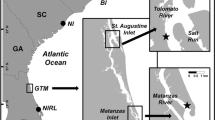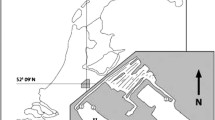Abstract
Seasonal abundance of planktonic larvae of the sand dollar Dendraster excentricus was determined in Monterey Bay, California, USA. Larvae were counted from two offshore stations and also over a coastal sand dollar bed, and these data were compared with settlement in the sand dollar bed, with adult population structure and with adult reproductive condition. These measurements were made during the period July 1978 to October 1980 and in October 1981. Sand dollar larvae were most abundant in the plankton during the summer, a period when phytoplankton productivity tended to be high and currents were relatively slow and variable. In some years, small-scale current variations appeared to prevent many larvae in the open bay from reaching the nearshore sand dollar beds; however, in other years, massive shoreward transport of the larvae evidently did occur, since the adult population in the sand dollar bed exhibited a mode in size, indicating a large settlement. A comparison of settled individuals in 1980 and the adult size-frequency distribution in 1981 gives an estimated mortality rate of 88% yr-1 for early juveniles of D. excentricus.
Similar content being viewed by others
Literature Cited
Birkeland, C. and F. S. Chia: Recruitment risk, growth, age and predation in two populations of Dendraster excentricus (Eschscholtz). J. exp. mar. Biol. Ecol. 6, 265–278 (1971)
Bolin, R. and Collaborators: Hydrographic data from the area of the Monterey Submarine Canyon, 1951–1955, 101 pp. Pacific Grove, California: Hopkins Marine Station, Stanford University 1964
Cameron, R. A. and S. Schroeter: Sea urchin recruitment: effect of substrate selection on juvenile distribution. Mar. Ecol. Prog. Ser. 2, 243–247 (1980)
Crisp, D. J.: Factors influencing the settlement of marine invertebrate larvae. In: Chemoreception in marine organisms, pp 177–265. Ed. by P. Grant and A. Mackie. New York: Academic Press 1974
Ebert, T. A. and D. M. Dexter: A natural history study of Encope grandis and Mellita grantii, two sand dollars in the Northern Gulf of California, Mexico. Mar. Biol. 32, 397–407 (1975)
Griggs, G. B.: Nearshore curent patterns along the central California coast. Estuar. cstl mar. Sci. 2, 395–405 (1974)
Highsmith, R. C.: Induced settlement and metamorphosis of sand dollar (Dendraster excentricus) larvae in predator-free sites: adult sand dollar beds. Ecology 63, 329–337 (1982)
Jackson, G. A. and R. Strathmann: Larval mortality from offshore mixing as a link between precompetent and competent periods of development. Am. Nat. 118, 16–26 (1981)
Meadows, P. and J. Campbell: Habitat selection by aquatic invertebrates. Adv. mar. Biol. 10, 357–382 (1972)
Merrill, R. J. and E. D. Hobson: Field observations of Dendraster excentricus, a sand dollar of western North America. Am. Midl. Nat. 83, 595–624 (1970)
Morin, J. A., J. E. Kastandiek, A. Harrington and N. Davis: An outer coast shallow subtidal sand community: its organization and patterns of interaction. Ecol. Monogr. (In press)
Pearse, J. S.: Reproductive periodicties of Indo-Pacific invertebrates in the Gulf of Suez. I. The echinoids Prionocidaris baculosa (Lamarck) and Lovenia elongata (Gray). Bull. mar. Sci. 19, 323–350 (1969)
Ricketts, E. F. and J. Calvin: Between Pacific tides, 4th ed. Revised by J. W. Hedgpeth, 614 pp. Stanford, California: Stanford University Press 1968
Smethie, W.: Some aspects of the temperature, oxygen and nutrient distributions in Monterey Bay, California. Tech Publs Moss Landing mar. Lab. 73-1, 1–97 (1973)
Sokal, R. R. and F. J. Rohlf: Biometry. The principles and practice of statistics in biological research, 776 pp. San Francisco, Calif.: W. H. Freeman & Co. 1969
Strathmann, R.: The spread of sibling larvae of sedentary marine invertebrates. Am. Nat. 108, 28–44 (1974)
Strathmann, R.: Length of pelagic period in echinoderms with feeding larvae from the Northeast Pacific. J. exp. mar. Biol. Ecol. 34, 23–27 (1978)
Thorson, G.: Some factors influencing the recruitment and establishment of marine benthic communities. Neth. J. Sea Res. 3, 267–293 (1966)
Timko, P.: Larviphagy and oophagy in benthic invertebrates: a demonstration for Dendraster excentricus (Echinoidea). In: Reproductive ecology of marine invertebrates, pp 91–106. Ed. by S. Stancyk. Columbia, South Carolina: University of South Carolina Press 1979
Woodin, S. A.: Adult-larval interactions in dense infaunal assemblages: patterns of abundance. J. mar. Res. 34, 25–41 (1976)
Author information
Authors and Affiliations
Additional information
Communicated by N. D. Holland, La Jolla
Rights and permissions
About this article
Cite this article
Cameron, R.A., Rumrill, S.S. Larval abundance and recruitment of the sand dollar Dendraster excentricus in Monterey Bay, California, USA. Mar. Biol. 71, 197–202 (1982). https://doi.org/10.1007/BF00394630
Accepted:
Issue Date:
DOI: https://doi.org/10.1007/BF00394630




